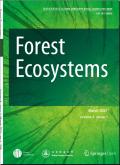基于太阳诱导叶绿素荧光的改进机器学习模型预测杨树人工林的总初级生产力
IF 4.4
1区 农林科学
Q1 FORESTRY
引用次数: 0
摘要
初级生产总值(GPP)与生态系统内的光合作用和蒸腾作用等过程密切相关,是全球碳-水-能源循环的重要组成部分。陆地生态系统GPP的准确预测是评价陆地碳循环过程的基础。机器学习(ML)模型为这一领域提供了重要的技术支持。目前,缺乏高精度、鲁棒的GPP预测变量和模型。必须解决诸如预测变量的不明确贡献、模型训练持续时间延长和鲁棒性有限等挑战。太阳诱导叶绿素荧光(SIF)、优化的多层感知器神经网络和集成学习模型显示了克服这些挑战的潜力。本研究旨在建立优化的多层感知器神经网络模型和集成学习模型,同时客观地评估SIF预测GPP的能力。最终目标是确定能够提高GPP预测准确性的稳健模型。利用黄淮海农业防护林系统杨树人工林生态系统指定研究观测站2020 - 2021年SIF连续观测数据和气象数据进行研究。通过对模型在不同时间尺度(半小时和日尺度)上的预测精度和鲁棒性进行优化和评价,构建了基于BP/MLP、MLP和随机森林集成(MLP-RF)集成模型的多层感知器(MLP)神经网络优化模型,以SIF作为GPP的主要预测变量。BP/MLP(半小时比例尺模型R2 = 0.885,日比例尺模型R2 = 0.921)和MLP-RF(半小时比例尺模型R2 = 0.845,日比例尺模型R2 = 0.914)模型均优于BPNN(半小时比例尺模型R2 = 0.841,日比例尺模型R2 = 0.918)和传统RF(半小时比例尺模型R2 = 0.798,日比例尺模型R2 = 0.867)模型,且BP/MLP模型始终优于MLP-RF模型。通过粒子群优化(PSO)优化BP/MLP模型,在半小时和日尺度上显著增强了GPP预测的鲁棒性。考虑到PSO-BP/MLP模型的半小时尺度和日尺度,光利用效率(LUE)、光合有效辐射(PAR)、吸收光合有效辐射(APAR)和SIF随NIRvP的变化(fSIF(NIRvP))这四个指标都显示出提高GPP预测精度的潜力。本研究采用了一系列模型优化技术,建立了一个性能更好的GPP预测模型,该模型能够客观地评价预测变量的贡献。该方法为陆地生态系统碳循环评估提供了一种创新而有效的方法。本文章由计算机程序翻译,如有差异,请以英文原文为准。
Predicting gross primary productivity of poplar plantations based on solar-induced chlorophyll fluorescence using an improved machine learning model
Gross primary production (GPP) is closely associated with processes such as photosynthesis and transpiration within ecosystems, which is a vital component of the global carbon–water–energy cycle. Accurate prediction of GPP in terrestrial ecosystems is essential for evaluating terrestrial carbon cycle processes. Machine learning (ML) models provide significant technical support in this domain. Presently, there is a deficiency of high-precision and robust GPP prediction variables and models. Challenges such as unclear contributions of predictive variables, extended model training durations, and limited robustness must be addressed. Solar-induced chlorophyll fluorescence (SIF), optimized multilayer perceptron neural networks, and ensemble learning models show the potential to overcome these challenges. This study aimed to develop an optimized multilayer perceptron neural network model and an ensemble learning model, while objectively assessing the capacity of SIF to predict GPP. Identifying robust models capable of enhancing the accuracy of GPP predictions was the ultimate goal. This study utilized continuous observations of SIF and meteorological data collected from 2020 to 2021 at a designated research observation station within the Populus plantation ecosystem of the Huanghuaihai agricultural protective forest system in Henan Province, China. By optimizing and evaluating the predictive accuracy and robustness of the models across different temporal scales (half-hourly and daily scales), a multi-layer perceptron (MLP) neural network optimization model based on the back propagation (BP) neural network (BPNN) algorithm (BP/MLP) and MLP and random forest (RF) integration (MLP-RF) ensemble models were constructed, utilizing SIF as the primary predictive variable for GPP. Both the BP/MLP (half-hourly scale model R2 = 0.885, daily scale model R2 = 0.921) and the MLP-RF (half-hourly scale model R2 = 0.845, daily scale model R2 = 0.914) models showed superior accuracy compared to the BPNN (half-hourly scale model R2 = 0.841, daily scale model R2 = 0.918) and the traditional RF (half-hourly scale model R2 = 0.798, daily scale model R2 = 0.867) models, with the BP/MLP model consistently outperforming the MLP-RF model. The BP/MLP model, which was optimized through particle swarm optimization (PSO), significantly enhanced the robustness of GPP predictions on a half-hourly scale and daily scale. Considering both half-hourly scale and daily scale in the PSO-BP/MLP modeling, the four indicators, light-use efficiency (LUE), photosynthetically active radiation (PAR), absorbed photosynthetically active radiation (APAR), and the variation in SIF with NIRvP (fSIF(NIRvP)), exhibited the potential for enhancing the accuracy of GPP predictions. This study employed a series of model optimization techniques to develop a GPP prediction model with enhanced performance that objectively evaluated the contributions of the predictive variables. This approach provided an innovative and effective method for assessing the carbon cycle in terrestrial ecosystems.
求助全文
通过发布文献求助,成功后即可免费获取论文全文。
去求助
来源期刊

Forest Ecosystems
Environmental Science-Nature and Landscape Conservation
CiteScore
7.10
自引率
4.90%
发文量
1115
审稿时长
22 days
期刊介绍:
Forest Ecosystems is an open access, peer-reviewed journal publishing scientific communications from any discipline that can provide interesting contributions about the structure and dynamics of "natural" and "domesticated" forest ecosystems, and their services to people. The journal welcomes innovative science as well as application oriented work that will enhance understanding of woody plant communities. Very specific studies are welcome if they are part of a thematic series that provides some holistic perspective that is of general interest.
 求助内容:
求助内容: 应助结果提醒方式:
应助结果提醒方式:


